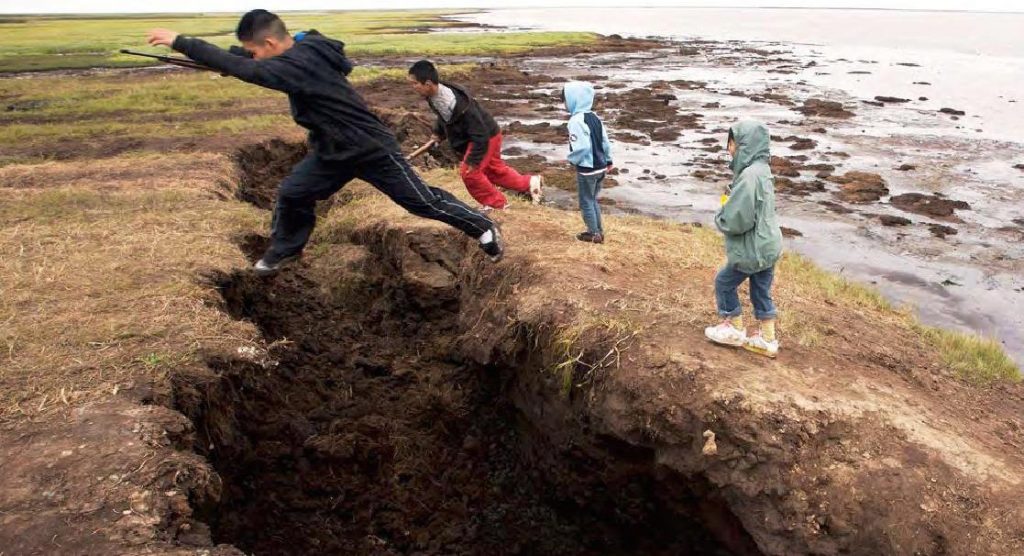Climate change will contribute to a wide range of health problems linked to Alaska, researchers say
The rapid change in Alaska’s climate is hazardous to human health, according to a new report from an Alaska state agency.

The rapid change in Alaska’s climate is hazardous to human health, according to a new report from an Alaska state agency.
Among the expected and observed effects discussed in the report: more wildfire producing lung-harming smoke, less of the sea and river ice needed for safe travel and flood protection, new disease vectors brought on by warmer temperatures and emotional stress resulting from disruption to traditional ways of living.
The report, issued last week by the Epidemiology Section of the Alaska Division of Public Health, was the first comprehensive report by the state of Alaska on health impacts of climate change. The 77-page document was the product of work that started in 2015, and followed up on the National Climate Assessment report issued in 2014, said Dr. Joe McLaughlin, chief of the state’s epidemiology section.
It is one of the few comprehensive reports issued to date about climate-change caused health risks in a particular state or region, McLaughlin said. Previous reports have been issued in Oregon and in New York City, he said.
Although the report is titled “Assessment of Potential Health Impacts of Climate Change in Alaska,” there is plenty of evidence that the impacts have already arrived, said McLaughlin and Sally Yoder, the report’s lead author and manager of the Alaska Health Impact Assessment Program within the state Department of Health and Social Services.
Some of those specific health problems are:
– Respiratory ailments caused by wildfire smoke from wildfires, which are increasing, and increasing quantities of pollen in the air. “We may already be seeing changes in respiratory illnesses,” McLaughlin said.
– New diseases from pathogens that are arriving in warmer conditions, such as bacteria that caused gastrointestinal ailments in 2004 for people eating Prince William Sound oysters. “We hadn’t ever seen it cause an outbreak in Alaska prior to the 2000s,” McLaughlin said. There is the possibility of new tick-borne diseases as well, he said.
– Increased incidences of shellfish tainted with toxins produced by algal blooms, which are more prevalent in warming waters. The most serious of those toxins produces paralytic shellfish poisoning, which can be deadly.
– Thawing permafrost, coastal flooding and erosion that undermines health facilities and transportation infrastructure, making it difficult for residents in remote areas to get medical services when they need them.
– A mental health condition called “solastalgia,” defined as the distressing sense of loss that people experience as a result of unwanted environmental changes that occur close to one’s home. Among the mental-health stresses already being felt, McLaughlin said, are concerns in coastal communities that need to relocate because of thawing and eroding shorelines, worries about how reduced sea ice has made it more difficult and more costly to harvest traditional wild foods and even loss of recreational activities, like skiing and dog-sledding, that previously provided happiness.
The report does not rank risks. Initially, there had been a goal of doing so, but it turned out that wide regional variation made such a general ranking impossible, Yoder said.
“It just became really evident that communities would be experiencing climate impacts in different ways,” she said.
Instead of using a statewide or regional ranking, the report gives recommendations for local communities to set priorities for health-care responses and adaptation measures. “Hopefully, communities can use the report to build awareness,” Yoder said.
Earlier studies led by University of Alaska Anchorage researchers used community surveys to establish a ranking for climate change effects on health in remote parts of the state.
The most acute impacts in those areas, the UAA research found, were from new dangers to people traveling across rural landscapes. Those risk factors include thinner ice of rivers traditionally used as travel routes, extreme storm conditions and lack of snow necessary for overland travel, said a UAA study published in 2016. Among the injuries suffered as a result of climate warming, ironically, were more cases of frostbite and hypothermia – cold-related injuries and ailments that happened when people got wet while traveling in winter.